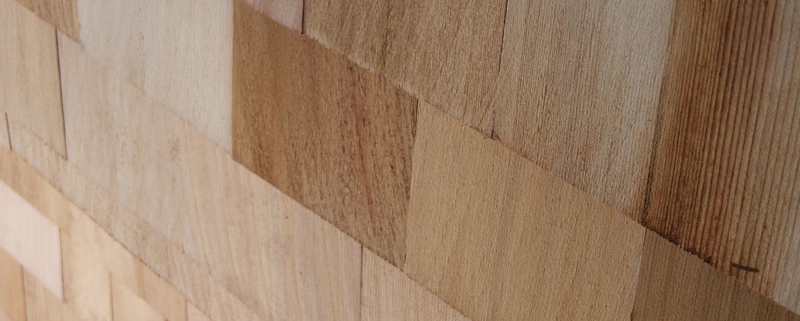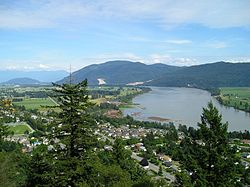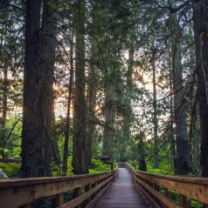Decorative Shingles – A Short History

From www.decorativeshingles.com
When mankind first started to build shelters, decoration became a part of the process. The overlapping of leaves, straw, and thatch along with the weaving of reeds, grasses and other fibres were part of man’s early, self-modified environment.
Over the centuries, patterns and decoration have become a part of manmade surroundings.
Modern structures appear as a collection of regular patterns made by bricks, stones, framing, siding, roofing, glass, tile, mouldings and panelling. By their very nature, these joined materials have become important elements of overall design.
Building materials are designed for structural considerations foremost. Bricks are laid in a staggered pattern because it gives the wall its maximum strength. Leaded glass allows just about any shape as long as it is strong enough and keeps out the wind and rain. The staggered and overlapping pattern of roofing slates and shingles is necessary for shedding water. Because of this basic consideration, weather resistant shingle designs are severely restricted when compared to the flexibility of other materials such as ceramic & mosaic tiles, parquet and inlaid flooring.
The enthusiasm for decorative millwork occurred when labour was enjoying a large increase in productivity brought on by the advancing industrial age. Mechanization, electricity and power tools were making a lot of basic construction tasks easier. This freed a lot of labour to work on decorative flourishes without incurring excessive additional costs.
The Victorian era was an age of intricate details and decorative shingles seemed to always be a part of this era. Many Georgian and Victorian buildings were roofed in clay tiles or slate. Gable ends and dormer walls were often clad with decorative slate and tiles.
Early settlers in North America used wood shingles from local species such as Cypress, Pine and White Cedar. Once easy access to the forests of western North America were established with the trans-continental railroads, Western Red Cedar became a favourite exterior finishing material. It was light, easy to work with, inexpensive, resisted rot and insects, and lasted extremely well on roofs and a lot longer on exterior walls.
Cedar trees often grow to great heights and thicknesses where their lower trunks are clear of knots, yielding the most valuable grade of wood; Clear edge grain. This cut of wood is universally prized, no matter what the species for its structural stability, strength and resistance to warping and splitting. For roofing purposes, edge grain and completely knot free are the requirements for a grade one shake or shingle.
Shingles can last for well over a hundred years if they are protected from the elements (eg; painted or on protected vertical walls). Cedar roofs do not last as long. As a result, all remaining examples of decorative shingle work from the late 1800’s and early 1900’s are of shingled walls, the original roof having long been replaced.
Alaskan Yellow Cedar Shingles

Other common names: Nootka cypress, sitka cypress, pacific yellow cedar. Found only on the Pacific coast of North America, Yellow Cedar is the hardest known cedar in the world. Prized by boat builders, it has exceptional resistance to weather and insects as well as easy workability. First used by the West Coast Indians for their historic Totem Poles and great war canoes, it is a rare and often difficult to find lumber species.
Its durability and ease of tooling makes it readily adaptable for the construction and finishing of homes, schools, factories, churches, recreational centers and a variety of commercial and industrial uses. It grows in a band from Southern Alaska to Southern Oregon. It is one of the slowest growing trees in North America and includes trees that are 700-1200 years old. 50-60 annual rings per inch are not uncommon. This rare and exceptionally beautiful wood species seeks out high and adventurous sites and often grows to the tree line. It is a medium sized tree, with a thin bark. It is slow growing with high disease and decay resistance, as well as oils that make it very aromatic. It grows from Alaska south to Oregon with the largest areas of growth in British Columbia and SE Alaska.
Alaskan Yellow Cedar has exceptional decay resistance combined with a fine texture, strength and straight grain. Its consistent yellow color gives it a characteristic unlike most other species, but the most outstanding characteristic of Yellow Cedar is its natural ability to weather uniformly to a consistent silvery grey on sidewalls and roofs, a characteristic that is highly sought after by discerning homeowners and architects.
Yellow cedar is a timber of the Pacific coast region of North America from Alaska to southern Oregon. It comes from a tree of modest size in comparison with others in these forrests, reaching 30m in height, with a trunk up to 1m in diameter. Found only on the Pacific coast of North America, Yellow Cedar is the hardest known cedar in the world. Only a limited amount of this wood is available every year. Yellow cedar is pale yellow and a little darker than Port Orford cedar and a little heavier than spruce. Prized by boat builders, it has exceptional resistance to weather and insects as well as easy workability. Yellow cedar dries well with little shrinkage, and once dry is noted for its stability in use. It is a moderately strong wood, stiff for its weight and with good shock resistance. It works easily and takes a good finish with both hand and machine tools. Like Port Orford cedar it is noted for its resistance to decay. Yellow cedar is an attractive, valuable but not very abundant wood, shipped in small quantities, mainly from British Columbia. It has many of the characteristics of Port Orford cedar and is used for similar purposes, in boat-building and for joinery and for furniture. It is an excellent wood for use out of doors; among its more specialized are engineers’ patterns, surveyors’ poles and it has always been considered one of the best woods for battery separators.
Clear Oil-Based Stains
Unless you prefer a naturally weathering more variegated appearance we suggest considering the application of a wood-preservative after a shingle installation or restoration is complete. Wood-preservative products used for this application are typically clear but are available in a variety of tints to provide varying levels of color to these products. Wood preservatives and stains are also available in semi-transparent, semi-solid and solid body which result in varying levels or opacity, texture and visible grain as well as color of course.
The products listed here are high-quality and we have seen them perform well and can recommend them for cedar shingle siding.
Armstrong Clark Exterior Wood Stains
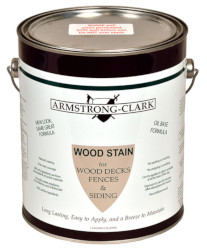
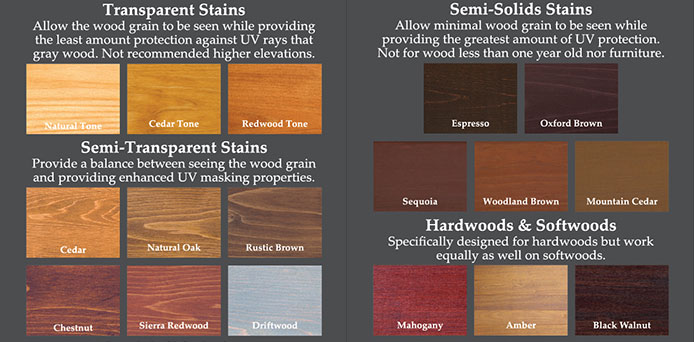
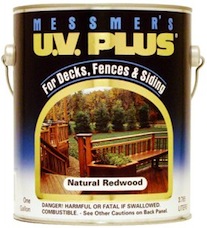

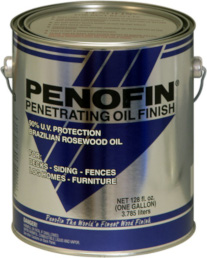
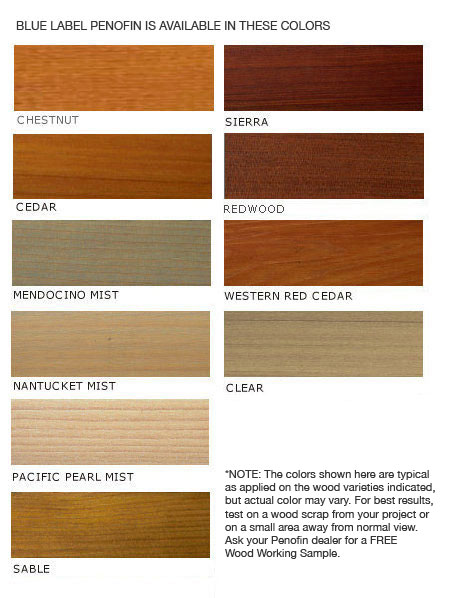
Cedar Shakes and Shingles…the Renewable choice.
Cedar Shakes and Shingles…the Renewable choice.
Quote from: Patrick Moore (Greenpeace Cofounder / Forest Ecologist):
“When it comes to building materials, wood is the only material that is renewable. Steel, concrete, plastic, and aluminum are all non-renewable resources; and in particular require a lot more energy and emit a lot more greenhouse gasses in their manufacturing. So far as an environmentally friendly building product, wood is the clear leader. One of the most sustainable things about western red cedar is that when it is harvested, virtually 100% of it goes either to lumber, shakes & shingles, pulp & paper, or energy into mills that make these products. One of the great things about choosing shakes & shingles is that it makes you part of the renewable cycle using a product that is designed by Mother Nature.”
From these building materials, wood is the most energy conserving and is the only material that is 100% reusable, recyclable, biodegradable and renewable.
Steel, aluminum, plastic and concrete are frequently thought of as wood substitutes. It is often incorrectly assumed that using these products will help protect our forests. But we cannot grow more iron ore to make steel, bauxite to make aluminum, petroleum to make plastic, or limestone to make concrete. These materials are mined or extracted from the earth, never to be replaced again. Even recycled wood substitutes contain large percentages of virgin, nonrenewable materials.
Consider wood for it:
- is a RENEWABLE RESOURCE.
- survives 130 mph hurricane-force winds
- has high insulation value – low energy costs
- is highly resilient in earthquakes
- withstands pounding hailstorms
- is aesthetically pleasing, offering lasting value
- is available with 30+ year warranties
- lasts a lifetime with pressure-impregnated fire retardant
- guards against decay with pressure preservative treatment
- protects the environment – It’s ENVIROSMART
Every time we use a product from a nonrenewable resource, we are diminishing the earth’s ability to sustain us. Wood roofing and siding, however is made form a resource that can be planted, harvested and planted again and again.
WOOD IS THE CHOICE FOR A SUSTAINABLE FUTURE
All of the mills that manufacture cedar shakes and shingles contribute to the replanting and maintaining of our natural resources. The province of British Columbia has some of the highest standards and toughest regulations in the harvesting of Western Red Cedar.
For more information on the state of North America’s forests visit:
Cedar Shingles, Forests & the Environment

From our friends at WoodRoof.com:
There is much concern these days about where our lumber and wood products are coming from, and rightly so. The environmentalists have succe eded in their goals to inform the world about the dangers of deforestation. They have created an atmosphere where the consuming public and world markets have demanded that logging companies, through governmental regulation, change their previously destructive logging practices. There has been many improvements in many parts of the world, but we are a long way from solving the problems of deforestation.
Western Red Cedar grows primarily on the west coast of North America in Oregon, Washington, British Columbia and Alaska. These areas have seen some of the most extensive changes in logging activity.
There are some distinctions that need to be made between logging for wood supply in western world and that of clearing land in developing countries. Logging companies in North America have huge forestry divisions that replant and care for all harvested areas. The land is given a helping hand to recover and replenish itself with the natural growth cycles of a forest. This is vastly different to cutting down virgin tropical rainforest to clear the way for new coffee plantations or banana crops.
In British Columbia, virtually 99% of the forests are owned by the people and managed on their behalf by the Provincial Government. Recent changes to the BC Forestry Practices Codes ensure that any timber harvested, be done so in absolute adherence to the laws of the land. The BC Ministry of Forests oversees these regulations. In fact, the BC Forestry Practices Codes were developed in conjunction with several international agencies, backed mostly by environmental and consumer groups. These agencies maintain a watchful eye on logging practices in BC and around the world. All parties involved work hard to create a balance between environmental concerns and economic issues on a local and global scale.
Yes – Western Red Cedar shingles and shakes are cut from temperate rain forest logs, but that is only part of the story.
The majority of red cedar handsplit & resawn shakes are produced from shake blocks. These blocks are harvested in a very environmentally friendly way. First of all, blocks come from areas that have been previously logged, somewhere between 100 years ago and yesterday. Decades ago, in many cases, cedar was left in the bush because it was not a marketable species. Blockers go in to these areas to find old dead and down cedar trees that will yield a wonderful raw material for shake production. In recent years, “blocker cutters” are actually sent in to an area prior to full scale logging to salvage this valuable, naturally dead and down resource. This is done in part to make the site safer for the loggers. Standing “snag” trees are a hazard as they can interfere with surrounding live trees that the logging companies harvest in larger quantities.
The blocker has to search the forest by foot for his scattered bounty. Blocks are cut to 24 inch (610mm) lengths and trimmed of knots and other defects. The trimmed, clean blocks are stacked in 1/3rd of a cord piles (1.0 m3) which are then lifted and flown to the waiting truck by helicopter. Very little of the natural flora is disturbed during this process. The next stop for the truckload of blocks in the shake mill.
In the case of sawn shingles – the mills are once again the scavengers of the forest industry. Lumber mills want solid, round logs of good length to make merchantable timber. Shake and shingle mills use the cedar logs that cannot be used for siding, decking, joinery, furniture and fencing. By cutting the short, broken, junky logs into 16 inch, (406mm) 18 inch, (457mm) and 24 inch, (610mm) lengths, a shingle mill can use logs that lumber mills reject.
Shake and shingle production is very labor intensive work. Each piece is touched by human hands many times during the process. This employs many workers and keeps local economies strong. It has been proven many times that for the same volume of wood harvested, the shake and shingle industry employs more workers, and yields more value that any other product made from Western Red Cedar.
More than just aesthetically beautiful, a shake or shingle roof has insulating properties that exceed those of most other products, many times over. Not only that, but the amount of energy required in manufacture a cedar roof is a mere fraction of that required to produce and transport asphalt shingles or tiles made from concrete or steel.
Now let’s talk about the life cycle of the roofing product. Where are we going to put all the asphalt shingles when their time is up? How long do they last? Then what happens to them? Like most man-made products, asphalt shingles remain “as is” in the landfill for many, many years. A wood roof recycles itself naturally, quickly, with no toxic waste left behind.
What could really be more environmentally sound that a naturally durable, naturally recyclable wood roof?
We highly recommend you check out the GreenSpirit web site. It contains a wealth of information on the environment and sustainable forestry.
© Govers Sidewall Shingling Berkeley, CA 510-339-6965 info@sidewallshingling.com - CA Lic. #677398




